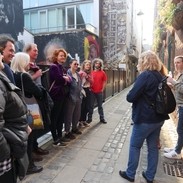Accessibility Statement for the VisitBritain Industry website
Photo by: VisitBritain/TAG

Accessibility Statement
This accessibility statement applies to the VisitBritain website at www.visitbritain.org.
This website is run by the British Tourist Authority t/a VisitBritain. We want as many people as possible to be able to use this website. For example, that means you should be able to:
- change styling using in-browser settings.
- zoom in up to 400% without the text spilling off the screen and without content being truncated or overlapping
- navigate most of the website using just a keyboard
- navigate most of the website using speech recognition software
- skip to the main content when using a screen reader or navigating with the keyboard.
- listen to most of the website using a screen reader (including the most recent versions of JAWS, NVDA and VoiceOver)
We’ve also made the website text as simple as possible to understand.
AbilityNet has advice on making your device easier to use if you have a disability.
How accessible this website is
We know some parts of this website are not fully accessible:
- Some decorative content is conveyed to screen reader users.
- There are non-descriptive links present on some pages.
- There are videos present which contain text on screen which does not have an alternative method of accessing.
- There is visually hidden content which is not programmatically hidden from users of assistive technology.
- There are combinations of text and non-text content and background colour which do not have sufficient colour contrast.
- Some pages have content that is not clearly written.
- Some PDF documents are not fully accessible.
- Some images do not have good alternative text.
Documents
- The website contains approximately 1000 PDFs and office documents. We are gradually replacing or removing any inaccessible documents created since 23 September 2018 and expect to complete this by 31 September 2025.
Webforms
- In the newsletter sign-up forms, the Privacy and Terms links in the CAPTCHA are not visible at 400% browser zoom. They are off the screen to the right, but there is no horizontal scrollbar, so it is not possible to scroll across to access them.
- In the forms, the inline error messages are not programmatically associated with the corresponding input field. Also, the inline error messages are hidden from assistive technologies. WCAG 2.1 SC 1.3.1 (Info and Relationships)
- In the newsletter sign-up forms, none of the textboxes has the required “autocomplete” attributes. W WCAG 2.1 SC 1.3.5 (Identify Input Purpose)
Interactive visualisations
- A few pages in the Research Insights section contain interactive visualisations of International Passenger Survey data that are not fully accessible. These are implemented using Microsoft PowerBI and we are currently working on improvements to them. We have provided the data in several other formats and are working to improve the offering.
What to do if you cannot access parts of this website
Please contact us on the details below should you require any content appearing on this website in a more accessible format, for example, a PDF.
More accessible formats may include large print, Easy Read, audio recording and Braille.
- email: [email protected]
- telephone: +44 (0) 20 7578 1400
We’ll consider your request and get back to you within ten days.
Reporting accessibility problems with this website
We’re always looking to improve the accessibility of this website. If you find any problems not listed on this page or think we’re not meeting accessibility requirements, contact:
- email [email protected]
- call +44 (0) 20 7578 1400
Enforcement procedure
The Equality and Human Rights Commission (EHRC) is responsible for enforcing the Public Sector Bodies (Websites and Mobile Applications) (No. 2) Accessibility Regulations 2018 (the ‘accessibility regulations’). If you’re not happy with how we respond to your complaint, contact the Equality Advisory and Support Service (EASS).
Technical information about this website’s accessibility
The British Tourist Authority is committed to making the VisitBritain Industry website accessible, in accordance with the Public Sector Bodies (Websites and Mobile Applications) (No. 2) Accessibility Regulations 2018.
Compliance status
The website has been tested against the Web Content Accessibility Guidelines (WCAG) 2.2 AA standard.
This website is partially compliant with the Web Content Accessibility Guidelines version 2.2 AA standard, due to the non-compliances and exemptions listed below.
Non-accessible content
The content listed below is non-accessible for the following reasons.
- Decorative content is exposed to users of screen reading assistive technologies. This fails WCAG 2.2 success criterion 1.1.1 (Non-text Content).
- Some links are not descriptive of their purpose or destination. This fails WCAG 2.2 success criteria 2.4.4 (Link in Purpose), and 2.4.9 (Link Purpose).
- Some text information is not marked up in a way to clearly convey the appropriate information for all users. This fails WCAG 2.2 success criteria 1.3.1 (Info and Relationships), and 2.4.6 (Headings and Labels).
- Information conveyed in a video is not accessible for all users. This fails WCAG 2.2 success criteria 1.2.1 (Audio-only and Video-only (Pre-recorded)), 1.2.3 (Audio Description or Media Alternative (Pre-recorded)), 1.2.5 (Audio Description (Pre-recorded)), and 1.2.8 (1.2.8 Media Alternative (Pre-recorded)).
We aim to make the required changes by March 2026. This statement will be updated regularly with timings of fixes. If you require any material on the website in an accessible format, please contact . [email protected]
Disproportionate burden
In April 2025 we received an accessibility test report for the full website, and we are evaluating the findings to determine the roadmap for fixing the issues and whether we will need to use the disproportionate burden exemption or not.
Content that’s not within the scope of the accessibility regulations
Office file formats published before 23rd September 2018 are exempt from the Public Sector Bodies (Websites and Mobile Applications) (No. 2) Accessibility Regulations 2018 (but not from WCAG), unless such content is needed for active administrative processes relating to the tasks performed by the public sector body.
What we’re doing to improve accessibility
We have implemented training for relevant staff, developed documentation, checklists, and resources to help us meet accessibility requirements and improve the digital experience for all visitors to our website. We will continue to perform accessibility audits in the future as we develop this website further.
Preparation of this accessibility statement
This statement was prepared on 3rd September 2025.
This website was last tested on 19th August 2025. The test was carried out by Digital Accessibility Centre Ltd.
Testing included a manual WCAG 2.2 audit which also included disabled user testing, and automated testing.
Testing was conducted on a representative subset of pages that contain examples of the most common layouts, components, and features, including:
- The header and footer.
- Important “unique pages”.
- Pages with text content.
- Pages with informational images, images of text and video content.
- Interactive elements such as forms, tabbed interfaces, carousels, hide / reveal functionality, and content filtering.
We will conduct further rounds of fixing and retesting until all the WCAG non-conformances have been fixed.






